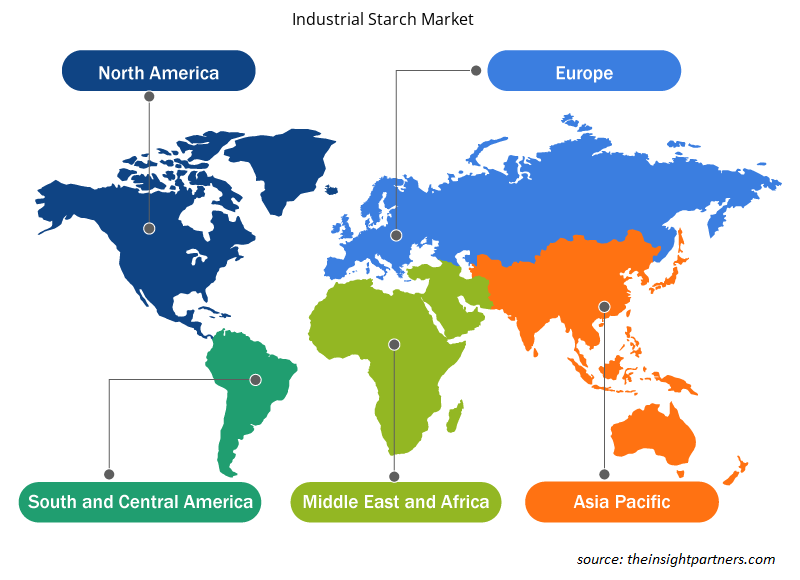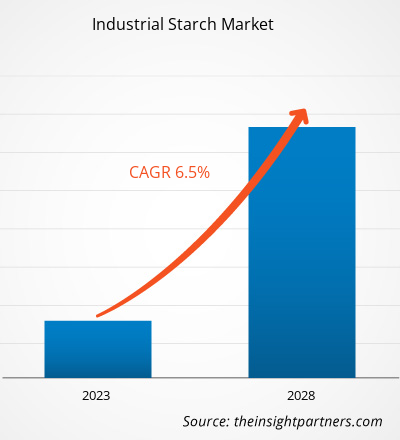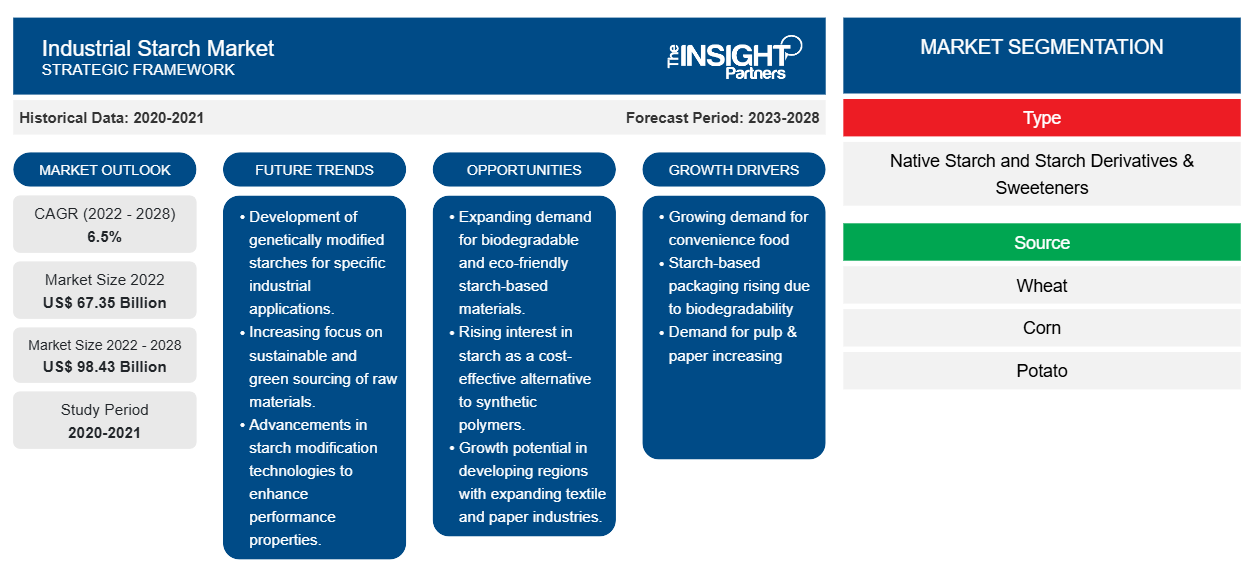[研究报告] 工业淀粉市场预计将从 2022 年的 673.5301 亿美元增长到 2028 年的 984.2674 亿美元;预计 2022 年至 2028 年的复合年增长率为 6.5%。
淀粉是一种复合碳水化合物,来源于小麦、玉米、土豆、木薯和大米。它是一种很好的能量来源。淀粉是各种食品和饮料的增稠剂/胶凝剂和稳定剂,包括烘焙和糖果产品、汤、酱汁、冷冻甜点、奶精和即饮饮料。由于消费者忙碌的生活方式和高人均收入,全球对方便食品的需求正在增加。此外,纸质食品包装需要涂层,以防止水或氧气渗透到包装中并破坏内部食品。通常,这种保护涂层由石油基塑料制成。然而,随着人们越来越意识到石油基塑料对环境的负面影响,制造商正在采用生物基和环保原材料作为纸质食品包装涂层。淀粉基包装的可生物降解性和价格实惠等特性正在推动制造商的普及。
过去几年,随着纸浆和造纸行业规模的扩大,该行业对淀粉的需求大幅增长。蓬勃发展的电子商务行业对瓦楞纸板的需求贡献巨大。此外,为确保环境可持续性而显著转向无塑料包装,推动了对可持续包装材料的需求。根据 Roquette Frères 的研究,由于 COVID-19 疫情期间电子商务行业的大幅增长,2020 年瓦楞纸板制造中工业淀粉的消耗量增长了 6%。因此,纸和纸板行业对淀粉的需求激增,正在提振工业淀粉市场
定制此报告以满足您的需求
您可以免费定制任何报告,包括本报告的部分内容、国家级分析、Excel 数据包,以及为初创企业和大学提供优惠和折扣
- 获取此报告的关键市场趋势。这个免费样品将包括数据分析,从市场趋势到估计和预测。
电子商务行业的增长使世界各地的制造商受益匪浅。在全球范围内,各种制造商和电子商务渠道都在推广使用可持续和环保的包装材料。随着电子商务行业越来越多地采用可持续包装材料,工业淀粉市场的增长预计将得到推动。印度电子商务公司 Myntra 和 Flipkart 已采取减少或消除包装材料中一次性塑料的使用。此外,政府减少塑料污染的政策预计将刺激对工业淀粉的需求。
市场洞察
工业淀粉应用范围广泛推动市场增长
近年来,工业淀粉在各种终端行业中的应用范围不断扩大。它被用作各种食品和饮料的增稠剂、胶凝剂和粘合剂,包括烘焙食品、汤和沙拉酱、糖果、酱汁、冰淇淋、果汁饮料和乳制品。淀粉还用于非食品应用,如纸浆和造纸、药品和动物饲料。在制药行业,淀粉用作片剂制造中的赋形剂和粘合剂。此外,淀粉基材料是可生物降解食品包装材料的完美解决方案,有助于减少环境污染。
类型洞察
根据类型,工业淀粉市场细分为天然淀粉和淀粉衍生物以及甜味剂。2021 年,淀粉衍生物和甜味剂细分市场占据了市场主导地位。由于可支配收入水平的提高和全球人口的增加,对食品和饮料的需求不断增长,以及淀粉衍生物在食品和饮料行业的使用是工业淀粉市场中淀粉衍生物细分市场最重要的增长动力。
Agrana Beteiligungs-AG、ADM、Ingredion Incorporated、Roquette Frères、Tereos Group、Cargill, Incorporated、Tate & Lyle PLC、Grain Processing Corporation、Royal Cosun 和 AVEBE 是工业淀粉市场的主要参与者。领先的参与者采用多种策略,例如并购和产品发布,以扩大其地理覆盖范围和消费者基础。
报告亮点
- 工业淀粉行业的进步趋势,帮助参与者制定有效的长期战略
- 公司采用的业务增长战略来确保发达市场和发展中市场的增长
- 2021年至2028年全球工业淀粉市场定量分析
- 各行业对工业淀粉的需求估计
- 波特五力分析说明工业淀粉行业买家和供应商的效力
- 了解竞争激烈的市场形势和工业淀粉的需求的最新发展
- 市场趋势和前景以及影响工业淀粉市场增长的因素
- 了解与市场增长相关的商业利益战略,帮助决策过程
- 工业淀粉市场各节点规模
- 市场详细概述和细分以及行业动态
- 各地区工业淀粉市场规模及增长潜力巨大
工业淀粉市场区域洞察
Insight Partners 的分析师已详细解释了预测期内影响工业淀粉市场的区域趋势和因素。本节还讨论了北美、欧洲、亚太地区、中东和非洲以及南美和中美洲的工业淀粉市场细分和地理位置。

- 获取工业淀粉市场的区域具体数据
工业淀粉市场报告范围
| 报告属性 | 细节 |
|---|---|
| 2022 年市场规模 | 673.5亿美元 |
| 2028 年市场规模 | 984.3亿美元 |
| 全球复合年增长率(2022 - 2028) | 6.5% |
| 史料 | 2020-2021 |
| 预测期 | 2023-2028 |
| 涵盖的领域 | 按类型
|
| 覆盖地区和国家 | 北美
|
| 市场领导者和主要公司简介 |
|
工业淀粉市场参与者密度:了解其对业务动态的影响
工业淀粉市场正在快速增长,这得益于终端用户需求的不断增长,而这些需求又源于消费者偏好的不断变化、技术进步以及对产品优势的认识不断提高等因素。随着需求的增加,企业正在扩大其产品范围,进行创新以满足消费者的需求,并利用新兴趋势,从而进一步推动市场增长。
市场参与者密度是指在特定市场或行业内运营的企业或公司的分布情况。它表明在给定市场空间中,相对于其规模或总市场价值,有多少竞争对手(市场参与者)存在。
在工业淀粉市场运营的主要公司有:
- AGRANA 担保公司
- 腺苷二磷酸
- 宜瑞安公司
- 罗盖特兄弟公司
- Tereos 集团
免责声明:上面列出的公司没有按照任何特定顺序排列。

- 了解工业淀粉市场顶级关键参与者概况
“2028 年工业淀粉市场分析”是一项针对化学品和材料行业的专业深入研究,侧重于市场趋势分析。该报告旨在提供市场概述和详细细分。工业淀粉市场根据类型、来源、应用和地理位置进行细分。根据类型,工业淀粉市场细分为天然淀粉和淀粉衍生物和甜味剂。根据来源,市场细分为小麦、玉米、马铃薯、木薯等。根据应用,市场细分为食品和饮料、纸浆和造纸、动物饲料、药品等。根据地理位置,分为五个主要地区:北美、欧洲、亚太、中东和非洲以及南美和中美洲。2021 年,亚太地区占据了工业淀粉市场的主导地位。
- 历史分析(2 年)、基准年、预测(7 年)及复合年增长率
- PEST和SWOT分析
- 市场规模、价值/数量 - 全球、区域、国家
- 行业和竞争格局
- Excel 数据集
近期报告
客户评价
购买理由
- 明智的决策
- 了解市场动态
- 竞争分析
- 客户洞察
- 市场预测
- 风险规避
- 战略规划
- 投资论证
- 识别新兴市场
- 优化营销策略
- 提升运营效率
- 顺应监管趋势























 获取免费样品 - 工业淀粉市场
获取免费样品 - 工业淀粉市场